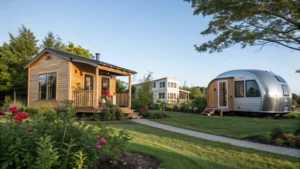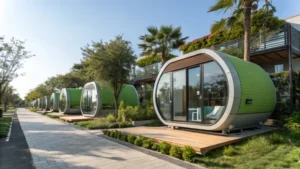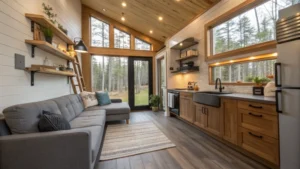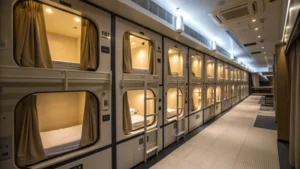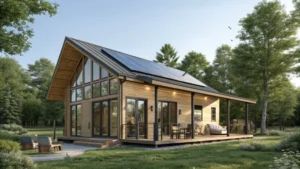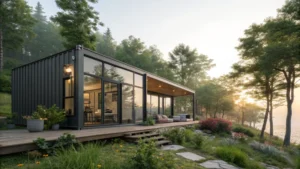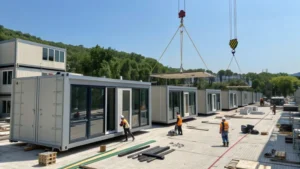
Ever wonder why those charming tiny homes come with such hefty price tags?
Tiny homes often surprise with their high costs due to premium materials, expert craftsmanship, limited production scale, and stringent regulations. Despite their small stature, the bespoke designs and intricate systems involved lead to unexpectedly high expenses.
When I first started exploring the world of tiny homes, I was captivated by the idea of a simpler, more affordable lifestyle. But as I delved deeper, I realized there was more to these pint-sized dwellings than met the eye. The allure of high-quality materials like sustainable cedar wood and energy-efficient systems quickly became apparent.
The craftsmanship involved in maximizing such a compact space is remarkable, yet it demands a higher price tag. Each tiny home often requires skilled labor to integrate advanced features like solar panels or smart home technologies. Moreover, these homes aren't mass-produced; they're usually customized to fit specific needs, adding to their cost.
Navigating regulations and obtaining permits can also be a costly affair. From zoning challenges to ensuring compliance with building codes, each step adds up. And let's not forget the transportation costs if your tiny home is mobile! Each of these factors combines to make tiny homes a bigger investment than many might expect at first glance.
Tiny homes use high-quality materials.True
High-quality materials are often used to ensure durability and aesthetic appeal.
Tiny homes benefit from economies of scale.False
Limited production means tiny homes don't benefit from reduced costs of mass production.
Why Do Tiny Homes Come with a Hefty Price Tag?
Ever wondered why those adorable tiny homes can cost a small fortune? Let me take you on a journey through the hidden expenses of these cozy abodes.
Tiny homes are expensive due to the use of high-end materials like sustainable insulation and energy-efficient windows. Custom designs and expert labor also drive up costs, as do advanced technologies like smart home systems and off-grid setups.

Premium Materials for Sustainability
You know, I’ve always been drawn to the charm of tiny homes. Yet, I was surprised by how expensive they can get. The secret? It’s all about those premium materials. Imagine using cedar wood that not only smells amazing but stands up to weather like a champ. Or those energy-efficient windows that keep the heat in during those chilly nights. These materials are not just about durability; they add a touch of elegance that makes a tiny home feel special.
Here's a quick comparison of common materials:
| Material Type | Benefits | Cost Implication |
|---|---|---|
| Cedar Wood | Durable, Weather-resistant | High |
| Energy-efficient Windows | Heat Retention | High |
Customization and Labor Costs
One of the most exciting parts of exploring tiny homes is the customization. I remember dreaming about having a mini gourmet kitchen inside one. But, as I delved deeper, I realized that every custom touch requires skilled craftsmanship. From intricate woodwork to innovative space-saving designs, each detail requires careful planning and precision. It's no wonder the labor costs are high, given how each element must fit perfectly into place.
For instance, incorporating luxury interiors1 requires precise craftsmanship, impacting the final price.
Limited Economies of Scale
Tiny homes are often crafted with love in small batches, much like your favorite artisanal goods. This means that unlike mass-produced houses, each tiny home carries higher production costs. It’s a bit like baking one cake instead of a dozen—you just don’t get the same savings on ingredients or effort. This limited scale leads to higher prices2 for raw materials and parts.
Off-Grid Technology and Smart Features
Then there’s the allure of going off-grid. Many tiny home enthusiasts, myself included at one point, dream of living sustainably. This often means equipping homes with solar panels and water filtration systems—innovations that bring freedom but come with significant upfront investments. Add in smart home features like automated lighting, and you’ve got a modern, efficient space that’s as costly as it is clever.
A simple breakdown:
| Feature | Functionality | Cost |
|---|---|---|
| Solar Panels | Off-grid energy | High |
| Smart Lighting | Automated control | Moderate |
| Water Filtration | Clean water supply | High |
Understanding these cost factors can truly help when deciding whether a tiny home is right for you. Explore more about smart home technologies3 for sustainable living.
Cedar wood is a low-cost material for tiny homes.False
Cedar wood is high-cost due to its durability and weather resistance.
Tiny homes are often built in large batches.False
Tiny homes are crafted in small batches, increasing production costs.
How Does Customization Impact Tiny Home Prices?
Ever wonder why the price tag on a customized tiny home is so hefty? Let me take you on a tour through the hidden costs of making a tiny space uniquely yours.
Customization can significantly drive up tiny home prices due to premium materials, skilled labor, and unique design requirements. These factors make personalized tiny homes more expensive than their standard counterparts.

The Role of Materials and Design
When I first started exploring the idea of customizing a tiny home, I was enchanted by the possibilities. Imagine choosing premium materials4 like cedar wood or energy-efficient windows that not only elevate the aesthetic but also enhance durability. But here’s the catch—these high-end selections can quickly increase the cost per square foot.
Skilled Labor Costs
Craftsmanship is where the magic happens, but it doesn't come cheap. I’ve seen firsthand how meticulous builders need to be when maximizing every inch of space. Their expertise in tailoring designs to unique needs5 means they command premium rates, making labor one of the priciest components.
| Aspect | Standard Build | Customized Build |
|---|---|---|
| Material Quality | Average | High-Quality |
| Labor Intensity | Moderate | High |
| Design Complexity | Standard | Tailor-Made |
Economies of Scale Limitations
Tiny homes are not mass-produced, which was a revelation to me. This lack of scale leads to higher production costs because builders can't leverage bulk buying benefits for materials. It’s a logistical dance that adds to the expense.
Integration of Technology
My dream tiny home always included off-grid solutions like solar panels, which add upfront costs. And equipping tiny homes with smart home technologies6 for lighting or climate control significantly boosts the total cost, but oh, the convenience!
Regulatory and Mobility Considerations
I learned that permits and zoning laws could be quite demanding. Customization might necessitate costly upgrades to comply with local regulations. Plus, if you're going mobile, factor in transportation costs. Whether your home rests on wheels or a permanent foundation, these choices further influence pricing.
Premium materials increase tiny home costs.True
Using high-quality materials like cedar wood raises the cost per square foot.
Mass production reduces tiny home customization costs.False
Tiny homes aren't mass-produced, limiting cost reduction through economies of scale.
Why Does Skilled Labor Increase Tiny Home Costs?
Ever wonder why tiny homes, those pint-sized marvels of modern living, can be surprisingly pricey?
Skilled labor elevates tiny home costs because it requires specialized craftsmanship to optimize limited space with intricate systems. This expertise significantly increases labor expenses.

The Importance of Craftsmanship
Building a tiny home feels a lot like crafting a Swiss watch—every tiny detail must fit perfectly. I remember watching builders at work, their focus intense, as they carefully fitted plumbing and electrical systems into spaces barely larger than a closet. These skilled artisans ensure that every square inch is used wisely, making their expertise invaluable—and yes, this precision comes at a premium.
This level of detail and attention to craftsmanship7 demands higher wages for skilled workers.
Customization and Design Complexity
When you think about it, tiny homes are like tailor-made suits. Each one is designed to fit specific needs, often including luxury interiors or eco-friendly tech. I once worked with a client who wanted bamboo floors and solar panels, all within a space the size of a small studio apartment. Crafting these bespoke designs requires not just skill but artistry, which naturally raises the labor costs.
This bespoke approach requires skilled artisans capable of turning innovative designs8 into reality.
| Factor | Impact on Cost |
|---|---|
| High-Quality Materials | Increases material cost |
| Skilled Labor | Raises labor expenses |
| Custom Designs | Enhances complexity |
Limited Economies of Scale
Unlike those sprawling suburban developments, tiny homes are usually built in smaller batches. This lack of mass production means builders can't save costs through bulk materials purchasing. I’ve seen firsthand how each unique model requires its own special touch, from sourcing materials to managing logistics—often leading to higher costs.
Tiny homes are often built in smaller batches or custom orders, unlike mass-produced traditional homes. This limits economies of scale, meaning that builders cannot leverage bulk production savings, making each unit more costly per square foot. The skilled labor required to craft each unique model9 further exacerbates this issue.
Integrating Advanced Systems
Many tiny homes come equipped with off-grid solutions like solar panels and energy-efficient appliances. Installing these requires specialized knowledge. I recall a time when integrating smart home technologies into a compact space was like putting together a complex puzzle—one wrong move, and you risked compromising the entire system. This expertise isn’t cheap, but it’s crucial for seamless living.
Installing these systems requires specialized knowledge and skills, which contribute to higher labor costs.
Understanding these factors gives you a clearer picture of why skilled labor is an essential and sometimes costly part of the tiny home equation. When considering building one, it's important to weigh these aspects carefully.
Skilled labor is necessary for tiny home construction.True
Skilled labor ensures precision and expertise, crucial for small spaces.
Mass production reduces costs for tiny homes.False
Tiny homes are often custom-built, limiting economies of scale.
How do regulations affect tiny home affordability?
When I first explored the world of tiny homes, I was captivated by the promise of affordable, minimalist living. But as I delved deeper, I discovered how regulations might be quietly inflating the costs.
Tiny home affordability is influenced by zoning laws, building codes, and permit requirements. These legal frameworks often necessitate costly modifications to meet mandated standards, impacting the overall cost of owning a tiny home.

The Role of Zoning Laws
Imagine dreaming of a tiny home nestled in a serene, picturesque location, only to find out that zoning laws restrict you to a few designated areas. This scenario was all too real for me when I first looked into where I could park my tiny sanctuary. Many municipalities view tiny homes10 as unconventional, which means strict zoning restrictions and sometimes exorbitant land-use fees.
-
Example Table of Zoning Restrictions
City Zoning Law Impact Cost Implications New York Prohibitive High land use fees San Francisco Limited areas Expensive compliance adjustments
Building Codes and Compliance
When building my tiny home, the challenge of adhering to traditional building codes became apparent. These codes are often not designed with tiny homes in mind, making compliance an expensive undertaking. Whether it was ensuring my home met stringent insulation standards or passing rigorous fire safety checks, each step added to the cost but was necessary for peace of mind and safety. The prospect of having to upgrade elements like structural integrity tests was daunting yet crucial for a secure dwelling.
- Key Compliance Challenges
- Insulation standards
- Fire safety measures
- Structural integrity tests
Permit Requirements and Costs
The journey to my dream tiny home included navigating a sea of permits—each with its own set of requirements and fees. From building permits to utility connections, these costs quickly add up, often turning a seemingly simple project into an intricate financial puzzle.
- Permit Types and Costs
- Building permit: $500 - $2,000
- Utility connections: $1,000 - $3,000
- Environmental assessment: $1,500 - $4,000
Impact of Regulatory Variability
One thing I've learned in my tiny home adventure is that location is key—not just for aesthetic reasons but also for regulatory ones. Some areas have more lenient rules, making them havens for tiny home enthusiasts seeking affordable living solutions. However, in regions with stricter regulations, the barriers and costs can be significant.
- Consideration Factors
- Regional differences in regulations
- Local government incentives or restrictions
Understanding the regulatory landscape11 is essential for anyone considering a tiny home. It allows potential owners to navigate obstacles and make informed decisions about where to build or park their homes, balancing both cost and compliance needs.
Zoning laws often restrict tiny home placement areas.True
Zoning laws limit where tiny homes can be placed, affecting affordability.
Building codes for traditional homes are easy for tiny homes.False
Tiny home builders face challenges meeting codes meant for larger homes.
Conclusion
Tiny homes often cost more than expected due to premium materials, skilled labor, customization, limited production scale, and regulatory compliance, making them a significant investment despite their small size.
-
Explore how luxury interiors enhance the appeal of tiny homes and why they contribute to higher costs. ↩
-
Learn why smaller production runs lead to higher costs for tiny homes due to limited economies of scale. ↩
-
Discover the impact of integrating smart technologies in tiny homes and how they affect overall expenses. ↩
-
Discover how premium materials enhance durability and aesthetics, influencing overall costs. ↩
-
Learn how unique design preferences affect labor intensity and costs in tiny home projects. ↩
-
Explore how integrating smart technologies can boost functionality and cost. ↩
-
Learn about the intricate details and skills required in tiny home construction. ↩
-
Explore how custom designs impact tiny home construction complexity. ↩
-
Understand how limited production affects costs in the tiny home industry. ↩
-
Learn how zoning laws can dictate where you can place your tiny home, affecting cost and feasibility. ↩
-
Understand the regulatory challenges and opportunities across different regions for tiny homes. ↩



